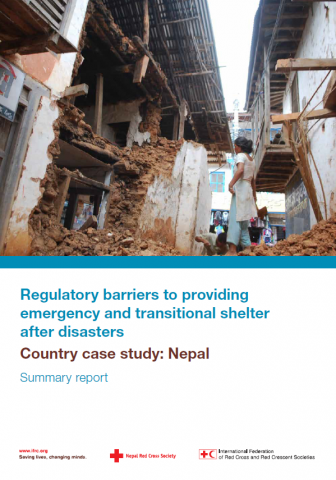Regulatory barriers to providing emergency and transitional shelter after disasters in Nepal


On June 11th, the Nepal Department of Urban Development and Building Construction (DUDBC) convened partners to launch a new study by the International Federation of Red Cross and Red Crescent Societies (IFRC) on “Regulatory barriers to providing emergency and transitional shelter after disasters” in Nepal. This study, undertaken by the IFRC’s Disaster Law Programme and Shelter and Settlements Department in close cooperation with the Nepal Red Cross Society (NRCS), was the most comprehensive country study that the IFRC has undertaken to date.
The study examines potential issues with land use planning, security of tenure, implementation of building codes, and equitable access to emergency and transitional shelter assistance. It identifies several positive developments that have already taken place, which are likely to reduce regulatory barriers, including the development of a new disaster management act (still pending) and the systematic development of disaster preparedness plans at the district level. The Nepal government has also worked to restrict development in 83 sites in Kathmandu City through an “open space” initiative, which designates particular sites for the use of temporary camps or for other humanitarian needs. Measures to strengthen implementation of the National Building Code through the digitization of approvals was also identified during the research undertaken for this study, as well as their integration into municipality by-laws and advocacy and training to improve compliance. Consultations with over 40 representatives from government ministries and departments, UN agencies, NGOs, development organizations, civil society and disaster-affected communities formed the basis of research, supplemented with in-country and desk-based analysis.
The report includes several suggested ways forward, including the development of a comprehensive, government-owned contingency plan for emergency and transitional shelter in preparation for a potential large-scale earthquake in Kathmandu Valley, as well as the development of an emergency and transitional shelter handbook for practitioners.
